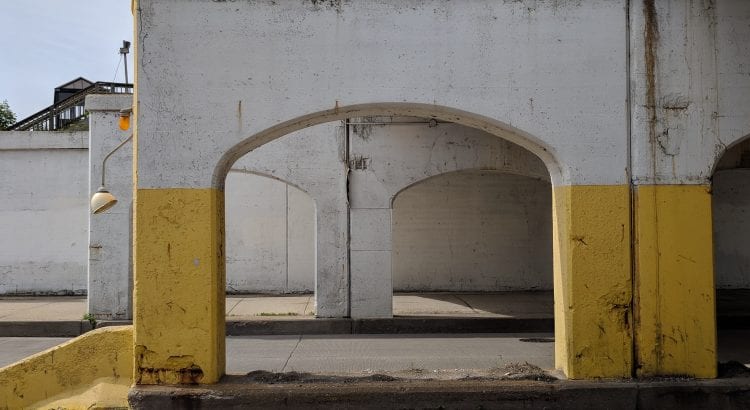It’s midday. I’m in Indiana at my mother-in-law Rosie’s house. Justin and I have come to spend a few days with her and, since we’re here and all, use her garage.
I need to paint 20 frames for an upcoming gallery show and the thought of me, Jackie “Oh, Did I Make That Mess?” Mantey, painting anything in our small apartment’s even smaller dining room nearly gives Justin a panic attack. (Poor guy had just recovered from some hives, which started not long after I decided to hand wash the dishes, a process that involves me swirling around and brilliantly reconfiguring whatever gooey gunk is decorating them. Then giving myself a huge pat on the back.)
So here I am, an Indiana artist for the day. I stand in my temporary studio, its regular vehicular tenants parked in the driveway to soak in some sun. I’m wearing ratty clothes, my hair high in a messy bun. Before I start painting, I take a minute to look around the subdivision. It’s a weekday, but children are playing outside. Summer vacation is in full swing. In fact, it just started, and so the cut grass still smells good and the hot blacktop still feels electrifying, even under tender bare feet. Popsicle brain freeze, sunburns, scraped knees, skulls shattered by the diving board, et al. The whole grab bag of other playing-outside maladies haven’t ruined anyone’s fun just yet.
I wave with my paint brush at a Sidewalk Boy rolling past on his scooter. They’re so cute when they’re pre-pubescent.
With that, I set about painting all of these frames a color called Hawaiian Luau Pink. I used to avoid my penchant for pink. It’s so feminine and totally not as cool as black, which I also like but not as much as I love pink. Choosing pink for these frames signals an acceptance of the part of myself that embraces traditional girlishness. It’s not the “girlishness” that bugs me. It’s the “traditional.” My experience is that people who like things done “traditionally” usually suck giant Hawaiian Luau Pink balls.
Rosie comes out to help me at one point and we have a great time. Listening to music, talking, painting, enjoying the breeze. Art-making offers a physical experience for creativity that writing just can’t. When you’re writing, your fingers and mind are working a mile a minute, but that’s about it. I like using my body to express something. Holding the frames tilted until my arms shake, just so I can get the right stroke angle for the paint brush. Pushing needle through a piece of paper until my pointer and middle fingers are calloused. Yes. More. Please.
One coat in and the color is is looking pretty dynamite. The rough wooden surface of the frames is taking the paint exactly like I expected, like I hoped it would. It’s seeping into every curve and splinter, acting as a highlighter, letting the old barn wood, which all the frames are made out of, tell its own story—just a little more fabulously than it would “traditionally.”
But I decide the paint’s soaking in pretty deeply as a base. A second coat is in order. The physicality and repetitiveness of going over one coat of paint with a second is even more therapeutic than the first go-round. Dip. Slow. Paint. Twist. Dip. Slow. Paint. Twist. As I finish dressing frames 18, 19, 20 in their second coat, I keep eyeing frames 1 through 10, which are nearly dry. Can I do a third coat? Should I? I really want to. Painting is so fun. I’m not tired yet. I’m not bored. This is giving me peace. I want to do another round.
An argument about whether or not to do this—because they really look pretty perfect with just two coats—swirls around inside me, like Sidewalk Boys circling their skateboards around the floor of an empty pool. My brow is furrowed when Rosie joins me in inspecting the frames. She confirms my suspicions: One more coat and the messy roughness of the frames would be overtaken, lost in the Luau, swimming in too many layers of pink. The story of the frames, of the work inside them and the wood than comprises them, would be drowned out.
I take a deep breath and agree. Put the paintbrush down. Watch the neighbor kids play.
